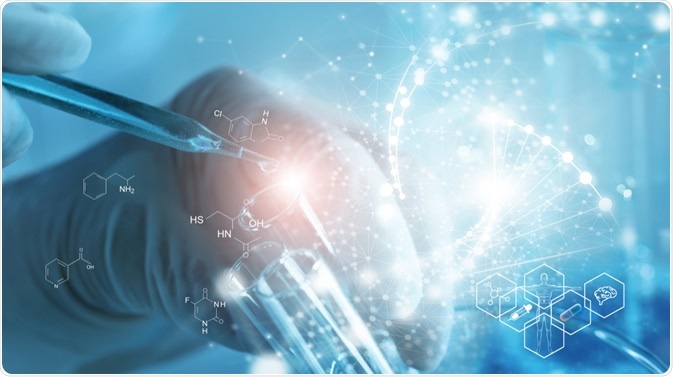Biochemistry is the field of science that studies the chemical processes taking place within living organisms at the molecular level, from the interaction of small molecule drugs with large macrobiomolecules such as protein complexes to the cascading dynamics of regulatory signaling molecules within and between cells.
 Image Credit: PopTika/Shutterstock.com
Image Credit: PopTika/Shutterstock.com
The field of biochemistry has become sufficiently diverse with variegated specializations as to warrant classification along with seemingly broader terms like chemist or biologist, with geneticists, microbiologists, botanists, medical researchers, and forensics professionals, to name a few, being reasonably categorized as biochemists.
Disregarding the more specific subsets of biochemistry such as genetics, biochemistry tends to focus on the role, structure, and function of biomolecules, as opposed to the fields of molecular biology, which focuses on the specific molecular mechanisms at play, or chemical biology, which studies the influence of small molecules on the biological system, though these terms are often mixed and are not usually strictly defined.
Biomolecules
The four primary biomolecules are carbohydrates, lipids, proteins, and nucleic acids, each of which frequently combines to form polymers and repeating units, exhibiting additional functional properties on the biomacro level that define living systems.
For example, single sugar monomer molecules provide a variety of functions depending on whether in cyclical or linear form, being components of DNA and the energy source of cellular metabolism. When joined together in short chains of around three to six monomers these sugar molecules fulfill signaling functions, and longer chains are heavily involved in cell surface receptor recognition interactions.
Lipids are extremely diverse, providing hydrophobic functions in living systems to act as a barrier, as in the cell membrane, and providing a medium in which hydrophobic molecules can dissolve. Meanwhile, many lipids are amphiphilic to provide both polar and non-polar regions, such as cholesterol.
Proteins facilitate structural and functional roles within the cell, acting as transporters and enzymes, while nucleic acids instruct and direct the proteins, at the simple level. Our understanding of biochemistry has advanced considerably in recent years, largely via the development of several key technologies that have allowed the scientific method to be applied to living organisms, where before identification and separation of microorganisms that would allow study was impossible.
History of biochemistry
The term biochemistry was reportedly coined in 1903 by Carl Neuberg, though the word was first recorded earlier in both English and German. Prior to this biochemistry may have been more commonly named physiological chemistry, though this was often more concerned with the investigation of extracellular processes such as digestion.
Ancient scholars had attempted to study human metabolism by weighing themselves or other methods, and some had an understanding that the human body was in a constant dynamic state.
Louis Pasteur’s discovery of the way in which the fermentation of sugar into alcohol was catalyzed by yeast could be considered one of the earliest true biochemistry experiments, and other enzymes were being characterized around this time in the 1800s.
Eduard Buchner received the Nobel prize in Chemistry in 1907 for his discovery of “cell free fermentation”, using an enzyme named zymase to ferment sucrose, and the function-based suffix nomenclature was employed for enzymes based on Buchner’s suggestion.
At this time it was not clear that enzymes were types of proteins, with proteins themselves being thought perhaps to be mere enzyme transporters. James Sumner demonstrated that enzymes were pure proteins by crystallizing them, supported by the further work of John Northrop and Wendell Stanley, the three of which also won the Nobel prize in 1946.
The ability to crystallize proteins allowed their structure to be examined in greater detail than ever before, and researchers began utilizing recently developed X-ray crystallography technologies in the 1960s and 1970s to reveal the structure of biomolecules in detail for the first time.
Frederick Sanger determined the complete amino acid sequence of bovine insulin in the early 1950s, demonstrating that proteins each had a defined and unique chemical sequence. He went on to develop methods of sequencing RNA and later DNA, introducing the dideoxy chain termination method for sequencing DNA that became the major method allowing so many sequences to be determined by other researchers since the 1980s, winning two Nobel prizes for these contributions.
Polymerase chain reaction allowed the newly developed sequencing technologies to be employed at sufficient sensitivity levels, and is the most widely utilized gene amplification technique in the modern laboratory, being indispensable to biochemical research.
It was developed in 1983 by Kary Mullis and involves denaturation of seed nucleotides, extension into nucleic acids, insertion of the target gene to be expressed, and finally amplification of this gene by complementary base pairing. Repeated heating and cooling cycles multiply the quantity of DNA or RNA in a sample exponentially, and the development of thermal cycler machinery in the 1980s also facilitated PCR technology.
Further Reading
Last Updated: May 25, 2021